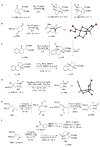Rapid assembly of complex cyclopentanes employing chiral, α,β-unsaturated acylammonium intermediates
- PMID: 24256870
- PMCID: PMC5548179
- DOI: 10.1038/nchem.1788
Rapid assembly of complex cyclopentanes employing chiral, α,β-unsaturated acylammonium intermediates
Abstract
With the intention of improving synthetic efficiency, organic chemists have turned to bioinspired organocascade or domino processes that generate multiple bonds and stereocentres in a single operation. However, despite the great importance of substituted cyclopentanes, given their prevalence in complex natural products and pharmaceutical agents, the rapid, enantioselective assembly of these carbocycles lags behind cyclohexanes. Here, we describe a Michael-aldol-β-lactonization organocascade process for the synthesis of complex cyclopentanes utilizing chiral α,β-unsaturated acylammonium intermediates, readily generated by activation of commodity unsaturated acid chlorides with chiral isothiourea catalysts. This efficient methodology enables the construction of two C-C bonds, one C-O bond, two rings and up to three contiguous stereogenic centres delivering complex cyclopentanes with high levels of relative and absolute stereocontrol. Our results suggest that α,β-unsaturated acylammonium intermediates have broad utility for the design of organocascade and multicomponent processes, with the latter demonstrated by a Michael-Michael-aldol-β-lactonization.
Figures



Similar articles
-
Multicomponent, Enantioselective Michael-Michael-Aldol-β-Lactonizations Delivering Complex β-Lactones.J Org Chem. 2018 Jan 19;83(2):632-643. doi: 10.1021/acs.joc.7b02543. Epub 2018 Jan 4. J Org Chem. 2018. PMID: 29219311
-
N-Heterocyclic carbene-catalyzed enantioselective synthesis of functionalized cyclopentenes via α,β-unsaturated acyl azoliums.Chem Commun (Camb). 2014 Dec 4;50(93):14539-42. doi: 10.1039/c4cc07433e. Chem Commun (Camb). 2014. PMID: 25307503
-
Asymmetric Organocatalysis: The Emerging Utility of α,β-Unsaturated Acylammonium Salts.Angew Chem Int Ed Engl. 2016 Nov 2;55(45):13934-13943. doi: 10.1002/anie.201602217. Epub 2016 Sep 21. Angew Chem Int Ed Engl. 2016. PMID: 27650693 Free PMC article. Review.
-
Direct catalytic asymmetric synthesis of N-heterocycles from commodity acid chlorides by employing α,β-unsaturated acylammonium salts.Angew Chem Int Ed Engl. 2013 Dec 16;52(51):13688-93. doi: 10.1002/anie.201306050. Epub 2013 Oct 31. Angew Chem Int Ed Engl. 2013. PMID: 24173690
-
α,β-Unsaturated acyl ammonium species as reactive intermediates in organocatalysis: an update.Org Biomol Chem. 2021 Mar 21;19(11):2366-2384. doi: 10.1039/d0ob02208j. Epub 2021 Mar 2. Org Biomol Chem. 2021. PMID: 33650626 Review.
Cited by
-
Stereoselective Lewis base catalyzed formal 1,3-dipolar cycloaddition of azomethine imines with mixed anhydrides.Chem Sci. 2015 Feb 1;6(2):1252-1257. doi: 10.1039/c4sc02612h. Epub 2014 Nov 19. Chem Sci. 2015. PMID: 29541440 Free PMC article.
-
Stereodivergent, Diels-Alder-initiated organocascades employing α,β-unsaturated acylammonium salts: scope, mechanism, and application.Chem Sci. 2017 Feb 1;8(2):1511-1524. doi: 10.1039/c6sc04273b. Epub 2016 Oct 21. Chem Sci. 2017. PMID: 28616147 Free PMC article.
-
Asymmetric synthesis of fully substituted cyclopentane-oxindoles through an organocatalytic triple Michael domino reaction.Chemistry. 2015 Jan 12;21(3):1004-8. doi: 10.1002/chem.201406047. Epub 2014 Dec 2. Chemistry. 2015. PMID: 25470781 Free PMC article.
-
Synthesis of Bridged Cyclopentane Derivatives by Catalytic Decarbonylative Cycloaddition of Cyclobutanones and Olefins.Angew Chem Int Ed Engl. 2016 Oct 24;55(44):13867-13871. doi: 10.1002/anie.201608158. Epub 2016 Oct 6. Angew Chem Int Ed Engl. 2016. PMID: 27712025 Free PMC article.
-
Zinc-mediated carboxylations of allylic and propargylic halides in flow: synthesis of β-lactones via subsequent bromolactonization.RSC Adv. 2023 Jan 24;13(6):3468-3473. doi: 10.1039/d2ra07715a. eCollection 2023 Jan 24. RSC Adv. 2023. PMID: 36756578 Free PMC article.
References
-
- Tietze LF, Brasche G, Gericke KM. Domino reactions in organic synthesis. Wiley-VCH; Weinheim: 2006.
-
- Pellissier H. Stereocontrolled domino reactions. Chem Rev. 2013;113:442–524. - PubMed
-
- Zhou J. Recent Advances in multicatalyst promoted asymmetric tandem reactions. Chem Asian J. 2010;5:422–434. - PubMed
-
- Grondal C, Jeanty M, Enders D. Organocatalytic cascade reactions as a new tool in total synthesis. Nat Chem. 2010;2:167–178. - PubMed
Publication types
MeSH terms
Substances
Associated data
- PubChem-Substance/164178426
- PubChem-Substance/164178427
- PubChem-Substance/164178428
- PubChem-Substance/164178429
- PubChem-Substance/164178430
- PubChem-Substance/164178431
- PubChem-Substance/164178432
- PubChem-Substance/164178433
- PubChem-Substance/164178434
- PubChem-Substance/164178435
- PubChem-Substance/164178436
- PubChem-Substance/164178437
- PubChem-Substance/164178438
- PubChem-Substance/164178439
- PubChem-Substance/164178440
- PubChem-Substance/164178441
- PubChem-Substance/164178442
- PubChem-Substance/164178443
- PubChem-Substance/164178444
- PubChem-Substance/164178445
- PubChem-Substance/164178446
- PubChem-Substance/164178447
- PubChem-Substance/164178448
- PubChem-Substance/164178449
- PubChem-Substance/164178450
- PubChem-Substance/164178451
- PubChem-Substance/164178452
- PubChem-Substance/164178453
- PubChem-Substance/164178454
- PubChem-Substance/164178455
- PubChem-Substance/164178456
- PubChem-Substance/164178457
- PubChem-Substance/164178458
- PubChem-Substance/164178459
- PubChem-Substance/164178460
- PubChem-Substance/164178461
- PubChem-Substance/164178462
- PubChem-Substance/164178463
- PubChem-Substance/164178464
- PubChem-Substance/164178465
- PubChem-Substance/164178466
- PubChem-Substance/164178467
- PubChem-Substance/164178468
- PubChem-Substance/164178469
- PubChem-Substance/164178470
- PubChem-Substance/164178471
- PubChem-Substance/164178472
- PubChem-Substance/164178473
- PubChem-Substance/164178474
- PubChem-Substance/164178475
- PubChem-Substance/164178476
- PubChem-Substance/164178477
- PubChem-Substance/164178478
- PubChem-Substance/164178479
- PubChem-Substance/164178480
- PubChem-Substance/164178481
- PubChem-Substance/164178482
- PubChem-Substance/164178483
- PubChem-Substance/164178484
- PubChem-Substance/164178485
- PubChem-Substance/164178486
- PubChem-Substance/164178487
- PubChem-Substance/164178488
- PubChem-Substance/164178489
- PubChem-Substance/164178490
- PubChem-Substance/164178491
- PubChem-Substance/164178492
- PubChem-Substance/164178493
- PubChem-Substance/164178494
- PubChem-Substance/164178495
Grants and funding
LinkOut - more resources
Full Text Sources
Other Literature Sources

